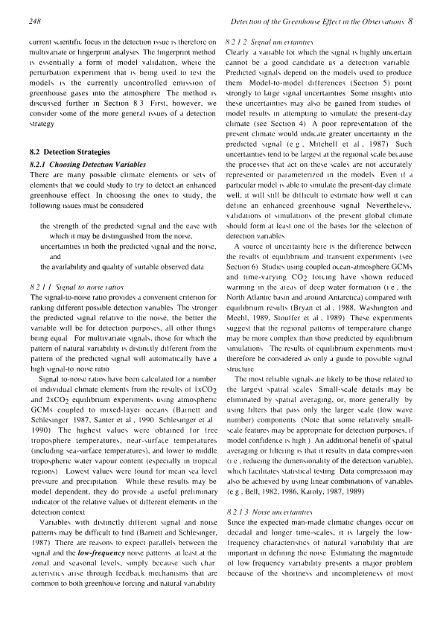First Assessment Report - IPCC
First Assessment Report - IPCC
First Assessment Report - IPCC
You also want an ePaper? Increase the reach of your titles
YUMPU automatically turns print PDFs into web optimized ePapers that Google loves.
248 Dctec tion of the Gieenhouse Effec t in the Ohsei \ations 8<br />
current scientific focus in the detection issue is thereloic on<br />
multivariate or fingerprint analyses The fingerprint method<br />
is essentially a form of model validation, wheie the<br />
perturbation experiment that is being used to test the<br />
models is the currently uncontrolled emission of<br />
greenhouse gases into the atmosphere The method is<br />
discussed further in Section 8 3 <strong>First</strong>, however, we<br />
consider some of the more general issues of a detection<br />
strategy<br />
8.2 Detection Strategies<br />
8.2.1 Choosing Detection Variables<br />
There are many possible climate elements or sets of<br />
elements that we could study to try to detect an enhanced<br />
greenhouse effect In choosing the ones to study, the<br />
following issues must be considered<br />
the strength of the predicted signal and the ease with<br />
which it may be distinguished from the noise,<br />
uncertainties in both the predicted signal and the noise,<br />
and<br />
the availability and quality of suitable observed data<br />
8 2 11 Signal to noise tatios<br />
The signal-to-noise ratio provides a convenient criterion for<br />
ranking different possible detection variables The stronger<br />
the predicted signal relative to the noise, the better the<br />
variable will be for detection purposes, all other things<br />
being equal For multivariate signals, those for which the<br />
pattern of natural variability is distinctly different from the<br />
pattern of the predicted signal will automatically have a<br />
high signal-to noise ratio<br />
Signal to-noise ratios have been calculated tor a number<br />
of individual climate elements from the results of lxCCb<br />
and 2xCC>2 equilibrium experiments using atmospheric<br />
GCMs coupled to mixed-layei oceans (Bainett and<br />
Schlesinger 1987, Santer et al , 1990 Schlesinger ct al<br />
1990) The highest values were obtained lor free<br />
troposphere temperatures, near-surface tempeiatures<br />
(including sea-surface temperatures), and lower to middle<br />
troposphenc water vapour content (especially in tropical<br />
regions) Lowest values were iound for mean sea level<br />
pressure and precipitation While these results may be<br />
model dependent, they do provide a useful preliminary<br />
indicator of the relative values of different elements in the<br />
detection context<br />
Variables with distinctly difleient signal and noise<br />
patterns may be difficult to find (Bamett and Schlesinger,<br />
1987) There are reasons to expect parallels between the<br />
signal and the low-frequency noise patterns at least at the<br />
zonal and seasonal levels, simply because such char<br />
actenstics anse through feedback mechanisms that are<br />
common to both greenhouse forcing and natural variability<br />
82 I 2 Signal umeitauities<br />
Clearly a vanable toi which the signal is highly uncertain<br />
cannot be a good candidate as a detection variable<br />
Predicted signals depend on the models used to produce<br />
them Model-to-model differences (Section 5) point<br />
strongly to laige signal uncertainties Some insights into<br />
these uncertainties may also be gained from studies ol<br />
model results in attempting to simulate the present-day<br />
climate (see Section 4) A poor representation of the<br />
present climate would indicate greater uncertainty in the<br />
predicted signal (e g , Mitchell et al , 1987) Such<br />
uncertainties tend to be largest at the regional scale because<br />
the processes that act on these scales are not accurately<br />
represented or paiametenzed in the models Even if a<br />
particular model is able to simulate the present-day climate<br />
well, it will still be difficult to estimate how well it can<br />
define an enhanced greenhouse signal Nevertheless,<br />
validations of simulations ol the present global climate<br />
should form at least one of the bases for the selection of<br />
detection variables<br />
A source of unccitainty hcie is the difference between<br />
the results of equilibrium and transient experiments (see<br />
Section 6) Studies using coupled ocean-atmosphere GCMs<br />
and time-varying CO2 loicing have shown reduced<br />
warming in the aieas of deep water formation (1 e , the<br />
North Atlantic basin and around Antarctica) compared with<br />
equilibrium results (Bryan ct al , 1988, Washington and<br />
Mcehl, 1989, Stouffer et al , 1989) These experiments<br />
suggest that the regional patterns of temperature change<br />
may be more complex than those predicted by equilibrium<br />
simulations The results of equilibrium experiments must<br />
therefore be considered as only a guide to possible signal<br />
structuie<br />
The most reliable signals aie likely to be those related to<br />
the largest spatial scales Small-scale details may be<br />
eliminated by spatial averaging, or, more generally by<br />
using filters that pass only the larger scale (low wave<br />
number) components (Note that some relatively smallscale<br />
features may be appropriate for detection purposes, if<br />
model confidence is high ) An additional benefit of spatial<br />
averaging or filtenng is that it results in data compression<br />
(1 e , reducing the dimensionality of the detection variable),<br />
which facilitates statistical testing Data compression may<br />
also be achieved by using linear combinations of variables<br />
(e g , Bell, 1982, 1986, Kaioly, 1987, 1989)<br />
8 2 13 Noise unteitamties<br />
Since the expected man-made climatic changes occur on<br />
decadal and longer time-scales, it is largely the lowfrequency<br />
characteristics of natural variability that are<br />
important in defining the noise Estimating the magnitude<br />
of low frequency variability presents a major problem<br />
because of the shoitness and incompleteness of most
















